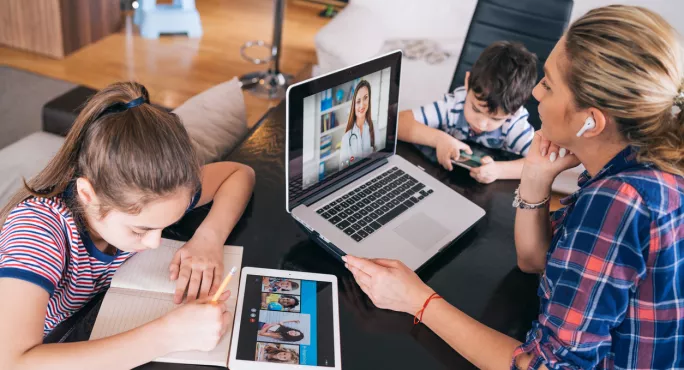- Home
- School reopening: 3 ways to help those who can’t return
School reopening: 3 ways to help those who can’t return

Like many schools around the world, we were closed for over two months as the Covid-19 epidemic gripped our country and our community.
We put a tremendous amount of energy into planning for continuity in remote learning and the special challenges this poses for families with young children, non-English speakers, and those who have returned home as the crisis began.
As an international school with over 60 nationalities, from all around the world, maintaining that unique sense of community was paramount.
Over time, we found ourselves devoting equal amounts of energy to the prospect of reopening the elementary school.
However, while this was good news for those still based in the country what would this mean for families who have relocated home, now unable to travel back, and based in a different time zone.
Or those with vulnerable family members, with health issues or other reasons that mean they cannot return to school.
What should we do for those who are not able to return to school for the remainder of this year?
These 3 key aspects have helped staff and students move forwards.
1. A flexible model for curriculum planning and delivery
No matter the curriculum framework, every school has systems for planning, recording and assessing curriculum.
When faced with such sudden change, we quickly realised that we needed to remodel our planning tools, to facilitate online learning, with and without adult support, both including face-to-face video-conferencing and without direct access.
We devised a weekly set of priority learning engagements, based on clear learning objectives, supported by short instructional videos made by the teacher, with linked Zoom sessions, and with a variety of ways to demonstrate learning outcomes, in key curriculum areas.
These were shared with parents and carers, together with any resources or links they might need.
We then added optional supplementary tasks, allowing for extension and continuation of learning, for those who wanted more. This means that internet access and time-based activities are not essential to continue learning.
The change was hard to achieve in the initial time-frame but has been refined and developed over the past 10 weeks, and now continues to form the basis of our blended-learning set-up.
Working on a two-day rotation continuously, students have ‘live learning’ sessions, including a check-in with their class teacher, on their at-home days, and other specialist lessons while in school, forming a balance that is intense, complex and (just) sustainable in the short-term.
It has become familiar and more manageable for staff, students and parents.
Students on the home-learning program full-time have access to all of the Zoom sessions, keeping connection and continuity of learning remotely.
2. Maintaining the essence of ‘community’
Weekly video conferencing with each class set of parents, right from the first week in lockdown, has given us a sense of the journey each family has taken.
Each individual family context is important and deserves acknowledgement for the way students are coping, surviving or thriving during this time.
Weekly virtual assemblies, shared with the whole elementary community, have given an opportunity to feel that this situation is bigger than just us.
Themes have included together, stay at home, rainbows of hope, how we learn affects what we learn, as well as a preparation for returning to school that explained some of the changes to expect. All of these have been appreciated by families.
One of the first requests from students, when we reopened, was that these assembly videos continue.
The theme this week was therefore “Same and yet different”, as we explored some of the changes and many of the things that remain at the heart of our school as we reopen.
These assemblies are watched by students in class, those who are on their home-learning rotation, and those who are not able to return to school.
This means everyone is still part of the community and still engaging.
3. Wellbeing for students, parents and staff
The primary concern of any institution is the safety and well-being of its community.
During the crisis, this has had many facets. Physical and mental well-being are paramount to learning, and every family has a different story.
Our video class-circles, our small group and 1-to-1 check-ins, and our communication channels for parents are all vital links.
Zoom staff meetings, team planning sessions and open communication from leadership have supported the process too.
It has been very important to continue to allow time and space for these stories to be told; each one gives insight into the other factors that can so easily be overlooked:
- The child who has lost a relative in a country far away.
- The staff member unable to return home for a funeral of a loved one.
- The family crisis completely unrelated to Covid-19, which put a student in intensive care fighting for his life
- The parents struggling to both work from home while supporting a challenging home-learning or blended learning program, and feeling they have failed their children.
- The teachers who are parents, too, and who have had to sacrifice their own conscience, and send their children back to Kindergarten so they can return to work.
No matter what comes next, the last 14 weeks of the school year 2019-2020 will remain unique in the minds and hearts of our community.
Sarah Ford is the elementary principal at Danube International School, Vienna, working with students aged 3-11 in an IB World School
Keep reading for just £1 per month
You've reached your limit of free articles this month. Subscribe for £1 per month for three months and get:
- Unlimited access to all Tes magazine content
- Exclusive subscriber-only stories
- Award-winning email newsletters


